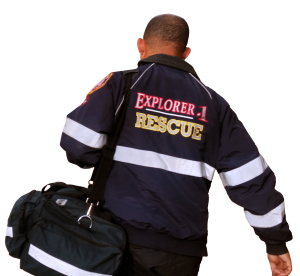
EMT | Emergency Medical Technician
Position:
EMT| Emergency Medical Technician
Explorer – 1 is currently looking for qualified individuals to join our Team that is determined about their profession and providing exemplary patient care. Explorer -1 is recruiting team players for EMT positions that are team-oriented, honest, caring, and compassionate.
Minimum Qualifications
Applicant must be a minimum of 18 years of age and hold a High School Diploma or equivalent; supplemented college-level course work (preferred). Emergency Medical Technician (EMT) Certification from a recognized EMT training program. State of California Licensure with Los Angeles County accreditation.
PRIMARY FUNCTION
Under general supervision, perform assessments of illness, or injuries; and administer basic emergency medical care. Provide emergency, or non-emergency rescue, care, and first-aid to the ill and injured, to include, but not limited to, the assessment of illness and/or injury, management of illness/injury, preparation for transport, transfer of information and qualified professional compassionate patient care.
EQUIPMENT USED:
Occasionally: spinal immobilization equipment, suction equipment, Traction splints, vacuum cleaner, television, kitchen appliances, hose, cleaning equipment and supplies, copy machine, computer/typewriter.
Frequently: Gurney, maps, bandaging, radio, airway equipment/airway bag, BLS disposable supplies, durable equipment, and trauma bag/box.
Constantly: Phone, Two Way communication (PTT), Pager, protective devices and clothing.
Required Certificates, Licenses, Registrations.
- State of California EMT Licensure,
- Los Angeles County Accreditation,
- CPR, and First Aid certification,
- Current Ambulance Driver Certification (Required for Driver applicants),
- Current Medical Examiners Certificate (Required for Driver applicants),
- Current California Driver’s License (Required for Driver applicants),
- Insurable driving record (Required for Driver applicants),
- DMV H-6 Printout Record (no more than 30 days old),
- In good standing with State & County EMSA.
Additional Information
Click on the links below to obtain addition information.
Essential Job Functions
EMT duties, and responsibilities shall include, but not limited to the following and can include additional duties that may be assigned Administer first-aid treatment and life-support care to sick or injured persons in pre-hospital setting.
- Perform or assist in the initial assessment and management of illness or injury to emergency patients in accordance with specified protocol and procedures.
- Have knowledge, and operation of equipment such as EKGs, external defibrillators, and bag-valve mask resuscitators.
- Assess nature and extent of illness or injury to establish and prioritize medical procedures.
- Maintain vehicles; medical and communication equipment; replenish first-aid equipment and supplies.
- Observe, record and report patient’s condition, or injury; the treatment provided, and changes/reactions to treatment.
- Perform the appropriate level of care, and treatment procedures, such as, but not limited to: suction, airway management, bandaging, splinting and vital sign monitoring during ambulance transport.
- Coordinate work with other emergency medical team members, fire department, and police personnel, and agencies.
- Communicate with dispatchers, and treatment center personnel to provide information about situation, to arrange reception of victims and to receive instructions for further treatment.
- Prepare or assist in the preparation of patients for transport, ensuring compliance with medical transport regulations, protocols, and procedures.
- Lead, guide, and/or assist in the training of new-hire candidates, and/or students as specifically assigned.
- Follow established company policies, procedures and objectives, continuous quality improvement objectives, and safety, environmental and/or infection control standards.
- Inspect emergency medical equipment to ensure serviceability and compliance with safety and infection control regulations and standards
- Complete and transfer patient care information and records as per established procedures.
- Comfort and reassure patients.
- Perform miscellaneous job-related duties as assigned.
- Drive emergency vehicles in stressful situations.
cum accusamus ullam voluptatibus commodi numquam, error, est. Ea, consequatur.
Required Skills
- Ability to maintain quality, safety and/or infection control standards.
- Report writing and records maintenance skills.
- Knowledge of, and skill in the application of basic life support protocol and procedures.
- Knowledge of, and skill in the application of basic on-site medical protocol and procedures.
- Ability to react calmly, and effectively in emergency situations.
- Knowledge of related accreditation and certification requirements.
- Knowledge of the use of medical transport procedures, facilities, and equipment.
- Ability to provide guidance and support to EMT staff and/or students.
- Knowledge of medical equipment maintenance regulations and policy standards.
- Ability to perform standardized emergency patient care activities within established
PHYSICAL DEMANDS
The Physical Demands of a EMT may vary significantly depending upon the situation in which they are called upon to perform their duties. Therefore, the ability to perform these demands efficiently is essential for the health, and safety of self, co-workers, and patients.
PHYSICAL REQUIREMENTS:
Occasionally: Climbing, kneeling, running distance. Lift and/or move up to 200 pounds.
Frequently: Walking inside and outside, lifting 100 pounds, pushing, pulling, reaching, balancing, carrying stopping, bending, leaning, sitting, driving ambulance. Standing, use hands to finger, handle, or feel; reach with hands and arms; and talk or hear.
Constantly: Hearing/listening, clear speech, touching, smelling, upper and lower body flexibility, seeing, (Including close vision, color vision, peripheral vision, depth perception, and ability to adjust focus) multiple physical activities at the same time.
Work Environment:
The work environment characteristics described here are representative of those an employee encounters while performing the essential functions of the job.
Working Conditions:
Occasionally: Confined areas, pressurized equipment, high places, noisy environments, toxic conditions, other hazardous conditions.
Frequently: Extended duty, inside, outside, temperature changes, wet and/or humid, noise, mechanical equipment, fumes/odors/mists, gasses, human excrement, blood, mucous, tissue.
Constantly: Works with and around others, face-to-face and verbal contact with others, shift work, noise
Stress Factors:
Occasionally: Boredom, MCI’s, life and death situation.
Frequently: Physically demanding, Repetitive tasks, high pressure, hazards, fatigue, intense tasks, high call volume.
Constantly: Simple and complex reading, writing, memorization, judgment, reasoning, and decision making.
EQUIPMENT USED:
Occasionally: spinal immobilization equipment, suction equipment, Traction splints, vacuum cleaner, television, kitchen appliances, hose, cleaning equipment and supplies, copy machine, computer/typewriter.
Frequently: Gurney, maps, bandaging, radio, airway equipment/airway bag, BLS disposable supplies, durable equipment, and trauma bag/box.
Constantly: Phone, Two Way communication (PTT), Pager, protective devices and clothing.
